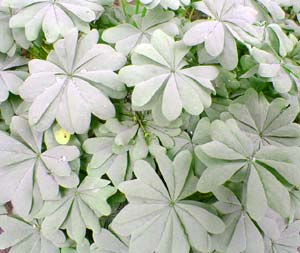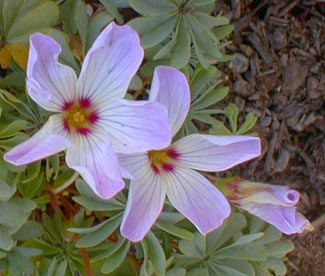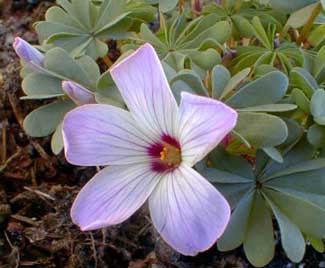
Chilean Wood Sorrel
"The winds of heaven gathered there
as pure & cold as dew;
Wood-sorrel & wild violets
along the hedgerows grew."
-Malcolm Hemphrey
fl.1920s
fl.1920s
Oxalis adenophylla or Chilean Oxalis is also known as Silver Shamrock, Pink Carpet Oxalis, Pink Buttercups, Pink Sauerklee, & Sandoxalis. It is extraordinarily cold-hardy, an Argentinian & Chilean alpine species gaining favor in such far-north locations as Sweden, Norway, & Nova Scotia, doing well down to USDA zone 4, but just as happy in purely temperate zones, & even tolerating heat up to zone 10 if soil is kept moist. Of course, its extreme winter hardiness is because the bulbs are adapted for freezing during dormancy, not that it has any winter presence per se.
 Its one problem is it is susceptible to rot in the winter in temperate zones, a problem it doesn't have where ground freezes in winter. In our mild Puget Sound weather, it has to be located in a spot with the best drainage possible to survive each year's dormancy period. That requirement met, it naturalizes easily. It has also been said to weaken in bloom over time, so may need to be lifted every few years in autumn so the bulbs can be separated & replanted.
Its one problem is it is susceptible to rot in the winter in temperate zones, a problem it doesn't have where ground freezes in winter. In our mild Puget Sound weather, it has to be located in a spot with the best drainage possible to survive each year's dormancy period. That requirement met, it naturalizes easily. It has also been said to weaken in bloom over time, so may need to be lifted every few years in autumn so the bulbs can be separated & replanted.Though tolerant of partial or dappled shade, it will bloom best with south-facing full sunlight. Our first two clumps faced southeast, but were otherwise not in the perfect location since the two spreading clumps were getting shaded much of the year by a vine maple & a butternut winter hazel, which means they were never as intensely floriferous as possible, plus one of the two clumps did rot away in winter. A third planting in a sunny south-facing rockery that is periodically a bit dry is a much sturdier clump.
It was the pleated leaves that first attracted me to this oxalis (as shown in the May 2003 photo first on this page). When not in bloom, it is only barely less gorgeous than when in full flower. Each half-foot tall leaf-stem is topped by a fluffily dense array of tiny folding heart-shaped leaves, more like grey-green flowers or ruffled collars than the usual oxalis leaves, & at first glance it does not quite look like an oxalis.
 When it blooms, the pale five-petalled flowers can be so dense over the leaves that in mid-spring & especially in summer the leaves may well disappear behind a wall of satiny pink with the faintest blue-violet veining, & maroon at the center.
When it blooms, the pale five-petalled flowers can be so dense over the leaves that in mid-spring & especially in summer the leaves may well disappear behind a wall of satiny pink with the faintest blue-violet veining, & maroon at the center.Before they open, the upright buds are a pretty shade of violet. The flowers are most intense in June & July, though in our zone it can start flowering earlier & last later.
Following its winter die-back, its leaves are returning by mid to late March, & given enough sunny days in late winter & early spring, it may already be flowering in April. The second photo is from April (2004), the first flowers of the year.
When planting the small brown bulbs, these have stringy hairy roots on the bottom, so are easy to tell down from up. These are planted at any time from September to November, to four inches deep. Young potted specimens can be installed at the tail end of winter or early spring.
It is excellent in a rock garden, & hardy in containers or as a houseplant too. It needs moist well-drained soil while growing, but prefers to be dry during winter, if not outright frozen.
It is not at all fussy about soil conditions, doing well in sandy, loamy, or clayey soils, in the acidic, neutral, or alkaline range. It certainly likes our loamy acidic soils.